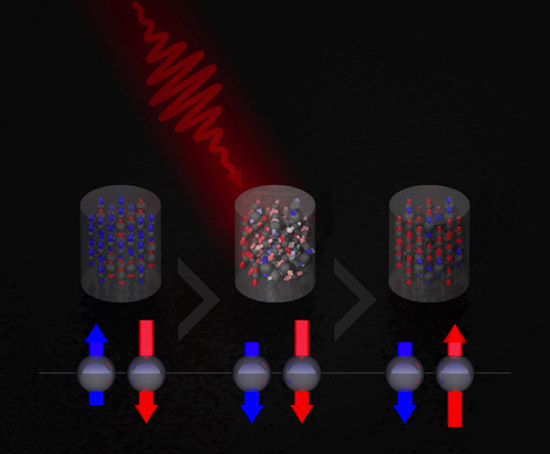Scientists began developing a method of "thermal" data recording

We all know that as the temperature rises, the magnetic properties of ferromagnets deteriorate, since thermal motion greatly impedes the orientation of the magnetic fields of the domains. For each of the known ferromagnets there is a temperature at which the domain structure of the material is destroyed, and the ferromagnet turns into a paramagnet. But it turns out that if a ferromagnet acts with a heat beam within a very small area, the heated domain is able to change the magnetic properties, according to an algorithm defined by the tester. This is a multiple process, so it is possible to create magnetic drives based on this principle.
The sample is heated by a laser flash, the duration of which is only a few hundredths of a picosecond. Scientists who develop this method of recording information work with nanometer-sized surface areas of a ferromagnet, which are affected by flashes of a laser beam. The researchers, who conducted the experiments, argue that much less energy will be spent on recording information in a similar way than in the case of the traditional method of recording using a magnetic field. In addition, the information will be recorded much faster. It is possible that “thermal” media will write data in terabytes in literally seconds.
')
If this method goes beyond the laboratory of researchers, then it can be called a breakthrough in computer technology (of course, first of all, this is a scientific breakthrough, which is then implemented in practice). Thermal recording allows simply not to pay attention to the limit in the magnetization reversal rate of a ferromagnet, which was determined eight years ago. That is why the speed of recording information on conventional hard drives remains the same, despite the increase in disk capacity.
Now the problem of this technology is not even in the complexity of the technical implementation, but that the recording will be made quickly, yes. But with the reading of the problem - it will have to be read in the usual way, which means there will be a normal speed. There are still some ways that, in theory, allow you to speed up the speed of reading information from the disk, but so far all these methods can not be implemented in the volume of the hard disk.
Via dvice
Source: https://habr.com/ru/post/137917/
All Articles